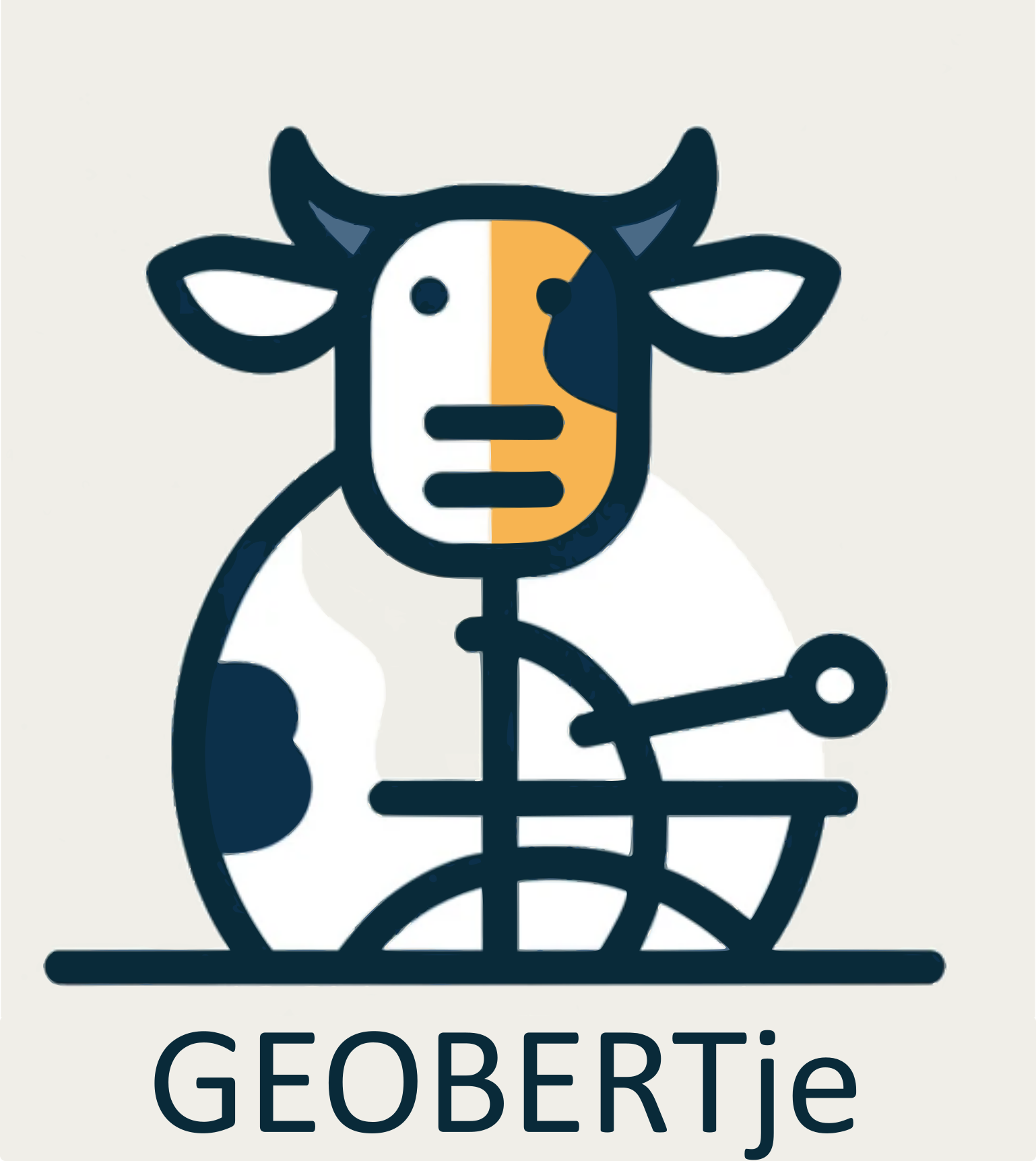---
language:
- nl
thumbnail: >-
geobertje.png
tags:
- GEOBERTje
---
# GEOBERTje
**A Domain-Adapted Dutch Language Model Trained on Geological Borehole Descriptions**
 ## Description
GEOBERTje is a language model built upon the [BERTje](https://github.com/wietsedv/bertje) architecture, comprising 109 million parameters.
It has been further trained using masked language modeling (MLM) on a dataset of approximately 300,000 borehole descriptions
in the Dutch language from Flanders region in Belgium.
It can serve as the based language model for a variety of geological applications.
For instance, by leveraging the model's understanding of geological terminology and borehole data,
professionals can streamline the process of interpreting subsurface information and generating detailed 3D representations of geological structures.
This capability opens up new possibilities for improved exploration, interpretation, and analysis in the field of geology.
## Usage
How to use GEOBERTje as a pipeline:
```python
from transformers import pipeline
pipe = pipeline("fill-mask", model="hghcomphys/geobertje-base-dutch-uncased")
pipe("grijs fijn zand met enkele [MASK]")
```
How to load it directly:
```python
from transformers import AutoTokenizer, AutoModel
tokenizer = AutoTokenizer.from_pretrained("hghcomphys/geobertje-base-dutch-uncased")
model = AutoModel.from_pretrained("hghcomphys/geobertje-base-dutch-uncased")
```
## Application
To showcase the potential application of GEOBERTje, we **fine-tuned** it on a limited dataset of 3,000 labeled samples.
This fine-tuning allowed the model to classify various lithological categories with higher accuracy than
traditional rule-based approaches or zero-shot classification using GPT-4.
Figure below shows comparative accuracy of rule-based, GPT-4, and GEOBERTje models in classifying
main, secondary, and tertiary lithology from geological drill core descriptions.
## Description
GEOBERTje is a language model built upon the [BERTje](https://github.com/wietsedv/bertje) architecture, comprising 109 million parameters.
It has been further trained using masked language modeling (MLM) on a dataset of approximately 300,000 borehole descriptions
in the Dutch language from Flanders region in Belgium.
It can serve as the based language model for a variety of geological applications.
For instance, by leveraging the model's understanding of geological terminology and borehole data,
professionals can streamline the process of interpreting subsurface information and generating detailed 3D representations of geological structures.
This capability opens up new possibilities for improved exploration, interpretation, and analysis in the field of geology.
## Usage
How to use GEOBERTje as a pipeline:
```python
from transformers import pipeline
pipe = pipeline("fill-mask", model="hghcomphys/geobertje-base-dutch-uncased")
pipe("grijs fijn zand met enkele [MASK]")
```
How to load it directly:
```python
from transformers import AutoTokenizer, AutoModel
tokenizer = AutoTokenizer.from_pretrained("hghcomphys/geobertje-base-dutch-uncased")
model = AutoModel.from_pretrained("hghcomphys/geobertje-base-dutch-uncased")
```
## Application
To showcase the potential application of GEOBERTje, we **fine-tuned** it on a limited dataset of 3,000 labeled samples.
This fine-tuning allowed the model to classify various lithological categories with higher accuracy than
traditional rule-based approaches or zero-shot classification using GPT-4.
Figure below shows comparative accuracy of rule-based, GPT-4, and GEOBERTje models in classifying
main, secondary, and tertiary lithology from geological drill core descriptions.
 ## References
Please see [this](https://github.com/VITObelgium/geobertje) repository for
further details on the training of GEOBERTje and its fine-tuning for the lithology classification task.
## References
Please see [this](https://github.com/VITObelgium/geobertje) repository for
further details on the training of GEOBERTje and its fine-tuning for the lithology classification task.
 ## Description
GEOBERTje is a language model built upon the [BERTje](https://github.com/wietsedv/bertje) architecture, comprising 109 million parameters.
It has been further trained using masked language modeling (MLM) on a dataset of approximately 300,000 borehole descriptions
in the Dutch language from Flanders region in Belgium.
It can serve as the based language model for a variety of geological applications.
For instance, by leveraging the model's understanding of geological terminology and borehole data,
professionals can streamline the process of interpreting subsurface information and generating detailed 3D representations of geological structures.
This capability opens up new possibilities for improved exploration, interpretation, and analysis in the field of geology.
## Usage
How to use GEOBERTje as a pipeline:
```python
from transformers import pipeline
pipe = pipeline("fill-mask", model="hghcomphys/geobertje-base-dutch-uncased")
pipe("grijs fijn zand met enkele [MASK]")
```
How to load it directly:
```python
from transformers import AutoTokenizer, AutoModel
tokenizer = AutoTokenizer.from_pretrained("hghcomphys/geobertje-base-dutch-uncased")
model = AutoModel.from_pretrained("hghcomphys/geobertje-base-dutch-uncased")
```
## Application
To showcase the potential application of GEOBERTje, we **fine-tuned** it on a limited dataset of 3,000 labeled samples.
This fine-tuning allowed the model to classify various lithological categories with higher accuracy than
traditional rule-based approaches or zero-shot classification using GPT-4.
Figure below shows comparative accuracy of rule-based, GPT-4, and GEOBERTje models in classifying
main, secondary, and tertiary lithology from geological drill core descriptions.
## Description
GEOBERTje is a language model built upon the [BERTje](https://github.com/wietsedv/bertje) architecture, comprising 109 million parameters.
It has been further trained using masked language modeling (MLM) on a dataset of approximately 300,000 borehole descriptions
in the Dutch language from Flanders region in Belgium.
It can serve as the based language model for a variety of geological applications.
For instance, by leveraging the model's understanding of geological terminology and borehole data,
professionals can streamline the process of interpreting subsurface information and generating detailed 3D representations of geological structures.
This capability opens up new possibilities for improved exploration, interpretation, and analysis in the field of geology.
## Usage
How to use GEOBERTje as a pipeline:
```python
from transformers import pipeline
pipe = pipeline("fill-mask", model="hghcomphys/geobertje-base-dutch-uncased")
pipe("grijs fijn zand met enkele [MASK]")
```
How to load it directly:
```python
from transformers import AutoTokenizer, AutoModel
tokenizer = AutoTokenizer.from_pretrained("hghcomphys/geobertje-base-dutch-uncased")
model = AutoModel.from_pretrained("hghcomphys/geobertje-base-dutch-uncased")
```
## Application
To showcase the potential application of GEOBERTje, we **fine-tuned** it on a limited dataset of 3,000 labeled samples.
This fine-tuning allowed the model to classify various lithological categories with higher accuracy than
traditional rule-based approaches or zero-shot classification using GPT-4.
Figure below shows comparative accuracy of rule-based, GPT-4, and GEOBERTje models in classifying
main, secondary, and tertiary lithology from geological drill core descriptions.
 ## References
Please see [this](https://github.com/VITObelgium/geobertje) repository for
further details on the training of GEOBERTje and its fine-tuning for the lithology classification task.
## References
Please see [this](https://github.com/VITObelgium/geobertje) repository for
further details on the training of GEOBERTje and its fine-tuning for the lithology classification task.